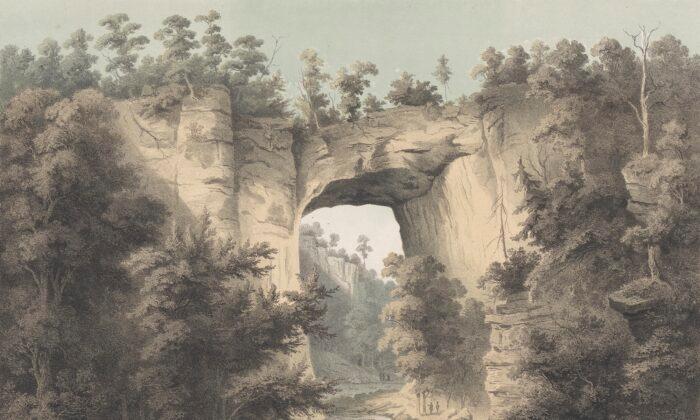On my way up to see Pennsylvania family and friends from my home in western North Carolina, I spotted a small road sign in Rockbridge County, Virginia, on Interstate 81 that piqued my interest. I pulled down a simple road and into a parking lot that indicated it was the entranceway to the official state and historical landmark called “Natural Bridge.”
Besides a short trail that afforded an opportunity for a bit of fresh air, I recognized that the forested path provided surprising historical tidbits. Primarily, placards indicated that George Washington once traversed the area and Thomas Jefferson built a home there.
Washington’s Mark, or Not
According to one historical marker, young George Washington worked as a surveyor long before he solidified his place in American history as commander of the Continental Army and as the country’s first leader. By age 20, Washington had completed around 200 surveys, and centuries of speculation put him at Natural Bridge during his travels, with “proof” in the form of his supposed initials carved into rock.Even though some historians question whether the initials are, indeed, Washington’s, there is less doubt that he navigated the area.
Jefferson’s Investment
Further research determined that Thomas Jefferson was so enamored with Natural Bridge that he purchased 157 acres of the surrounding land in 1774, just two years before the War for Independence. Jefferson paid 20 shillings to obtain the land warrant, get the property surveyed, and file the necessary papers with the secretary of the colony in Williamsburg. Jefferson’s rustic Rockbridge County property was 120 miles (by horse) from his more refined Monticello property, so he built a two-room log cabin retreat near Natural Bridge and invited family and friends to view the fascinating site. A few later guests would become historically noteworthy, including Henry Clay, Sam Houston, and Martin Van Buren.Jefferson wrote about the area:
“Looking down from this height about a minute, gave me a violent head ach[e]. If the view from the top be painful and intolerable, that from below is delightful in an equal extreme. It is impossible for the emotions arising from the sublime, to be felt beyond what they are here: so beautiful an arch, so elevated, so light, and springing as it were up to heaven, the rapture of the spectator is really indescribable!”
Jefferson’s family members were just as enthralled. Cornelia Jefferson Randolph, one of Jefferson’s granddaughters, wrote in 1817: “We are return’d from the natural bridge more anxious to see it again than we were at first, because in the first place it far surpass’d our expectations.”
Jefferson retained ownership of his Natural Bridge property until his death in 1826. Afterward, the property was sold and stayed in private hands until an arrangement was made with the Virginia Department of Conservation and Recreation.
Visitors to this historic area have an opportunity to contemplate how Washington might have, and how Jefferson certainly did, stand captivated by the lofty rock arch that man’s hands did not create.





